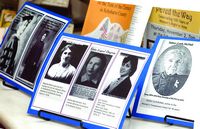Subscriptions
Menu
Advertisements
On the 100th anniversary of women's right to vote...
11/7/2017 |
By Patsy Nicosia |

When it came to getting women the vote, Schoharie County was no suffrage stronghold.
But those church groups, card clubs, literary societies, and even the Red Cross, and the DAR?
Sometimes the biggest revolutions are launched behind the scenes.
On the 100th anniversary of women winning the right to vote, that’s just some of the history Summit author Karen Cuccinello shared at the Schoharie Free Library Thursday in a presentation from her just-published “Women Who Paved the Way at the Turn of the Century in Schoharie County.”
Schoharie County voters twice denied giving women the vote, Ms. Cuccinello said, both in 1915 and again in 1917—though that second time, November 6, 1917, it passed on the statewide ballot.
“When you consider who was voting—men—that’s not surprising,” she said.
Still, her book features the biographies of about 150 local women who advanced the cause and other women’s rights issues.
Esther Lord McNeil lived in both Carlisle and Rochester, and though she wasn’t involved in the suffrage movement, she was active in the Women’s Christian Temperance Union, which lobbied strongly for both causes.
Another surprise proponent of suffrage? The Grange, which Ms. Cuccinello said gave equal voting rights to men and women from day one.
Mrs. Charles Humphrey was another local leader, Ms. Cuccinello said; her husband was a pharmacist with a reputation for “not being a nice guy.”
“Most of the movers and shakers in the movement had money,” Ms. Cuccinello added. “Many of them were married to doctors and pharmacists. Many also didn’t have children, which gave them more time…”
Patty Braley and her step-sister, Susan Armstrong, both of Cobleskill; Eleanor Taylor of Schoharie, and Catherine Lawrence are among the other women featured and pictured in Ms. Cuccinello’s book.
Ms. Taylor’s car is on exhibit at the Old Stone Fort; Ms. Lawrence, who lived 1820-1904, was one of the first Civil War nurses and even ended up with a pension “which sure wasn’t normal; even the guys had to fight for them,” Ms. Cuccinello said.
Because photography was new in the 1900s and men—not women—were the first to be photographed, Ms. Cuccinello said finding photos of the women she was writing about was difficult.
Many of the photos she did find, she said, are from college yearbooks, including Syracuse University, Penn State, and Vassar—something that points to the fact that suffragettes were more likely to be better educated.
Ms. Cuccinello has no photos of Flora Shafer of Blenheim, active in women’s causes until she left the county in the 1930s “after some indiscretion,” but she does have a photo of Ms. Shafer’s descendant Gail Shafer, former Blenheim supervisor and Secretary of State, whom Ms. Cuccinello said “remembers the whispers” about ‘Aunt’ Flora.
As the years pass, the names of the women in Ms. Cuccinello become more familiar: Martha Taylor Dayton of Jefferson, a Democrats, elected the town’s first woman supervisor in 1965 and chairman of the Board of Supervisors 1970-71, and Nellie Gordon Crosby of Cobleskill, the county’s first woman lawyer among them.
Ms. Taylor died in 1996 and Ms. Crosby in 1997.
Ms. Cuccinello’s research turned up a report of a local visit and talk by Susan B. Anthony in 1875, years before the suffrage vote, along with a newspaper report that “it was a flop financially.”
“I didn’t find another account of her coming back,” Ms. Cuccinello said.
Ms. Cuccinello said women used the friendships forged in local groups to press their cause; volunteering with the Red Cross also made them more visible and indispensable, she said.
“Schoharie County doesn’t jump out at you at all, in terms of activism,” she added.
“But women got things done behind the scenes.”









